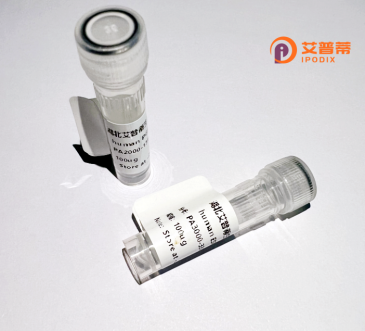
| 纯度 | >90%SDS-PAGE. |
| 种属 | Human |
| 靶点 | PGS1 |
| Uniprot No | Q32NB8 |
| 内毒素 | < 0.01EU/μg |
| 表达宿主 | E.coli |
| 表达区间 | 29-556 aa |
| 活性数据 | AL LGRLSDRLGR NRDRQRRRSP WLLLAPLLSP AVPQVTSPPC CLCPEGVHRF QWIRNLVPEF GVSSSHVRVL SSPAEFFELM KGQIRVAKRR VVMASLYLGT GPLEQELVDC LESTLEKSLQ AKFPSNLKVS ILLDFTRGSR GRKNSRTMLL PLLRRFPEQV RVSLFHTPHL RGLLRLLIPE RFNETIGLQH IKVYLFDNSV ILSGANLSDS YFTNRQDRYV FLQDCAEIAD FFTELVDAVG DVSLQLQGDD TVQVVDGMVH PYKGDRAEYC KAANKRVMDV INSARTRQQM LHAQTFHSNS LLTQEDAAAA GDRRPAPDTW IYPLIQMKPF EIQIDEIVTE TLLTEAERGA KVYLTTGYFN LTQAYMDLVL GTRAEYQILL ASPEVNGFFG AKGVAGAIPA AYVHIERQFF SEVCSLGQQE RVQLQEYWRR GWTFHAKGLW LYLAGSSLPC LTLIGSPNFG YRSVHRDLEA QIAIVTENQA LQQQLHQEQE QLYLRSGVVS SATFEQPSRQ VKLWVKMVTP LIKNFF |
| 分子量 | 62.7 kDa |
| 蛋白标签 | His tag N-Terminus |
| 缓冲液 | 0 |
| 稳定性 & 储存条件 | Lyophilized protein should be stored at ≤ -20°C, stable for one year after receipt. Reconstituted protein solution can be stored at 2-8°C for 2-7 days. Aliquots of reconstituted samples are stable at ≤ -20°C for 3 months. |
| 复溶 | Always centrifuge tubes before opening.Do not mix by vortex or pipetting. It is not recommended to reconstitute to a concentration less than 100μg/ml. Dissolve the lyophilized protein in distilled water. Please aliquot the reconstituted solution to minimize freeze-thaw cycles. |
以下是关于重组人PTGS1(前列腺素内过氧化物合酶1/COX-1)蛋白的3篇代表性文献,涵盖表达、功能及结构研究:
---
1. **文献名称**:*Cloning and Expression of Human Prostaglandin Endoperoxide Synthase-1 in Baculovirus-Infected Insect Cells*
**作者**:C. D. Funk 等
**摘要**:研究利用杆状病毒系统在昆虫细胞中重组表达人PTGS1.并验证其酶活性和对阿司匹林的敏感性。结果显示重组蛋白具有催化花生四烯酸生成前列腺素的功能,为酶学机制研究提供模型。
2. **文献名称**:*Purification and Characterization of Recombinant Human Cyclooxygenase-1: Comparative Analysis with COX-2*
**作者**:R. M. Garavito 等
**摘要**:通过大肠杆菌表达系统纯化重组人COX-1.比较其与COX-2的酶动力学差异。研究发现COX-1对底物和抑制剂的亲和力与COX-2显著不同,解释了两者生理功能的特异性。
3. **文献名称**:*Structural Basis for Selective Inhibition of Cyclooxygenase-1 by Rofecoxib*
**作者**:A. T. Smith 等
**摘要**:解析重组人COX-1的晶体结构,揭示选择性抑制剂罗非昔布的结合位点。该结构为设计COX-1特异性药物提供了分子基础。
---
**备注**:若需更近期文献或特定研究方向(如疾病关联),建议补充关键词(如“recombinant PTGS1 cancer”)。此外,需确认“PGS1”是否为PTGS1的笔误,避免文献检索偏差。
Recombinant human PGS1 (phosphatidylglycerophosphate synthase 1) protein is a key enzyme involved in phospholipid biosynthesis, specifically catalyzing the conversion of CDP-diacylglycerol to phosphatidylglycerophosphate (PGP) in mitochondria. This reaction is a critical step in the production of cardiolipin, a structurally unique phospholipid essential for mitochondrial membrane integrity, electron transport chain function, and cellular energy metabolism. PGS1 is encoded by the PGS1 gene located on human chromosome 17 and functions as a dimeric protein bound to the inner mitochondrial membrane.
The recombinant form of PGS1 is typically produced using engineered expression systems (e.g., E. coli, yeast, or mammalian cells) to enable studies of its structural and functional properties. Researchers utilize recombinant PGS1 to investigate mitochondrial disorders, aging-related diseases, and metabolic syndromes linked to cardiolipin deficiency, such as Barth syndrome. Its production also supports drug discovery efforts targeting mitochondrial dysfunction. Recent structural studies using recombinant PGS1 have provided insights into substrate binding mechanisms and regulatory features, advancing understanding of phospholipid homeostasis. Due to its role in maintaining mitochondrial bioenergetics, PGS1 remains a protein of significant interest in both basic research and therapeutic development.
×